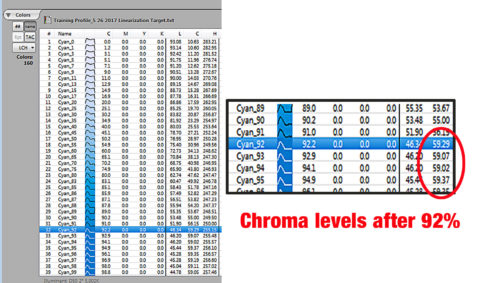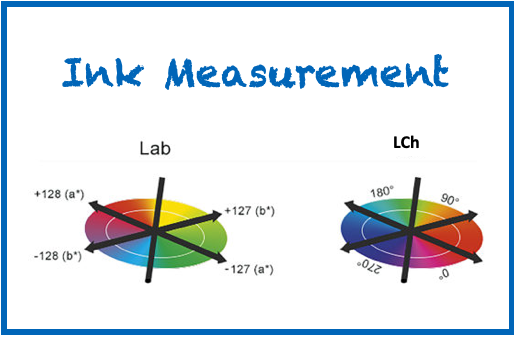Many printers practice ink management by limiting combined process inks (CMYK and +) through a color profiling process. This common practice, called TAC adjustment, can help control ink costs, drying, curl and paper cockle by limiting the overall volume of ink printed. It’s easy to forget that overall inkjet TAC is based on managing primary inks first.
C, M,Y and K are the primary ink foundation upon which a color profile is built. This foundation determines the color space the combined inks can produce. Before profiling, or even thinking about the G7 methodology, ensure you are not printing more ink than the substrate can accommodate.
When printing on highly calendared or coated papers used for high speed, or industrial products (such as plastics, metal and glass) ink chroma can top-out way before 100% printed value. Why print higher percentages of ink when there is no extra color benefit?
Primary Inks and the “C” in LcH
Each ink has a measured color value called L*C*h. The L*C*h color space, sometimes called HCL, is similar to CIELAB. L*C*h is preferred by some industry professionals because it correlates to color perception of the human eye. It uses the L*a*b* diagram represented in cylindrical coordinates instead of rectangular coordinates. The C in this color space refers to chroma, a color’s purity or the amount “colorfulness” of the printed ink. Measuring the chroma of a primary color tells us the percentage value at which we no longer gain any color value by adding ink. This is called “topping-out”.

We commonly use CIELAB when talking about color matching or measuring printed values to define color difference in terms of delta (dE). LCh is not as commonly referenced by customers or on press, but is an important measurement for ink management.
In this color space, LcH determines color values of:
- L* = lightness and darkness (lighter or darker)
- C* = chroma/colorfulness (brighter or duller)
- H* = hue (shade or property of color)
How and Where to Manage
Adjusting your primary inks can be done at the RIP or DFE (digital front end) of the inkjet device if your device allows adjustments to curve values in 5% or smaller increments, or at the linearization stage when developing an output profile. If managing at the RIP or DFE, at prepress or press one must remember to apply these curve adjustments to each paper/weight previous to running the print job. Best practice is to include primary adjustments within the output profile used at the DFE or off line RIP. When managed manually at the DFE curve level, adjustments may be forgotten or applied incorrectly, creating room for error and an extra step in the color management process.
Managing primaries at the linearization stage of profiling is the most efficient. Properly created color profiles manage primary ink levels through the linearization step and include this information in the output profile. This output profile can be applied at the RIP or the inkjet device; keeping all ink management within the profile settings, nice and tidy.
Inkjet devices which conduct the linearization step through the DFE are not automatically measuring to determine if primaries are topped out, they are only correcting highlight, mid-tone and 3/4 tone values. To ensure you are not printing more ink than you need to achieve color, this must be measured manually or through software which does it automatically.
The example below shows Cyan’s value when printed on a coated stock ramping during the linearization process. The linearization correction is set to limit by chroma and marks the value at which a color tops and/or levels-out showing percentage values which add no color benefit to the profile.

Coated high hold out substrate printed with aqueous pigment ink.
Linearization based on chroma top-out at 92%. X = chroma reduction at 89% to be corrected automatically.

Curve values plotted showing needed percentage value correction at 89% and 92% chroma top-out.

Chroma data from linearization curves above showing cyan top-out at 92%, with 7% wasted ink.
The example above shows a 7% savings for cyan, but all primary 4 or + inks can also have savings. In many cases for high speed inkjet in non or low porous media, cyan and black chroma will top out around 90% and up. For industrial inkjet, the savings are much higher, as a colors top-out much earlier because UV inks have a much higher pigment load than aqueous. Ink savings depend on the substrate, ink chemistry, pigment load, wet-out, dpd (drops per dot) drop volume and speed to drying or curing.
Since colorants affect inkjet jetting requirements, UV, aqueous or hybrid inkjet inks are developed to a fixed chemistry. This chemistry can vary greatly according to the print head, jetting speed, substrate and use requirements. Unlike traditional print methods, an ink’s primary color base cannot be altered by the user, but only reduced in volume or mixed with other colors to simulate a target color.
We often forget, ink management is a multi step process through primary ink management and overall profile TAC ink reduction. When profiling for the inkjet process, managing primaries first, is critical to creating proper color profiles that do not use more ink than required.
Other Benefits of Ink Management
Limiting primaries has other benefits beyond ink savings. Evaluating your solid primaries can help in reduction of ink coalescence, color to color bleed, ink build, identification of slower drying inks that cause streaking, picking, offsetting and roller build up slowing your production process. Primary ink management saves time and drives efficiency when managed properly.
Need help evaluating your ink management? Looking for ways to save ink, reduce print defects, gain additional drying and production speed? Let us know, we are here to help.

